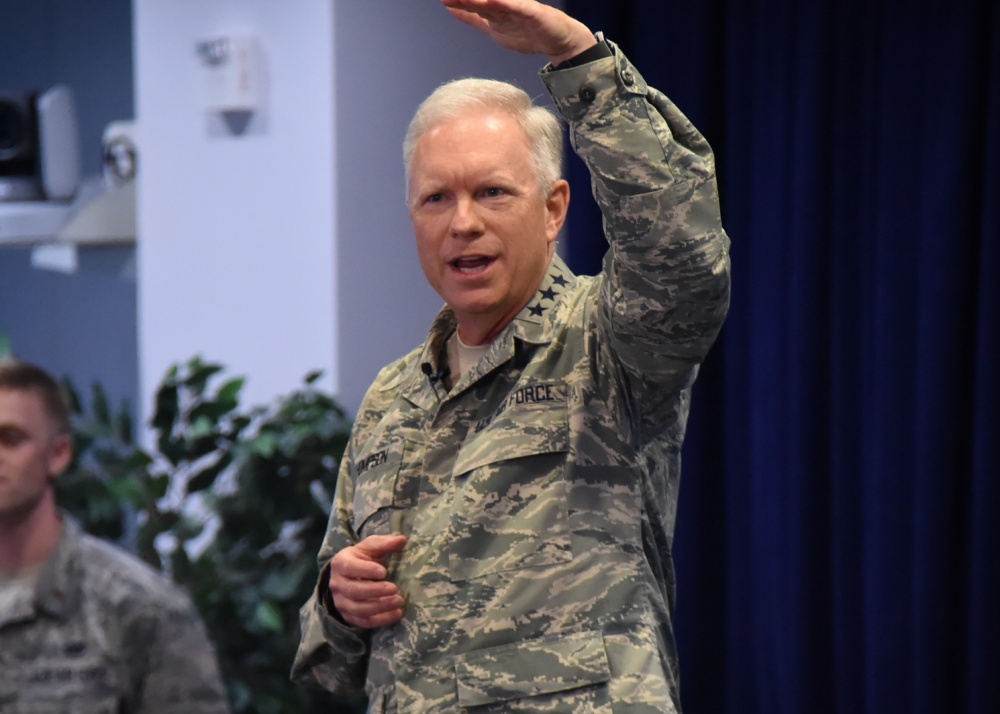
Lt. Gen. JT Thompson
WASHINGTON: The Space Force hopes its new acquisition command, Space Systems Command, will be ready for business by early summer, says Lt. Gen. ‘JT’ Thompson, head of the Space and Missile Systems Center.
“I’m not telling anybody: ‘Hey, this is going to be easy, peasy,” he told the Air Force Association’s Schriever chapter today. “There is history; there is legacy; there is politics; there is money: obstacles that we’re going to have to overcome to do this.”
SMC, the military’s central space acquisition unit, will play a key role, but it’s unclear exactly how it will fit in the new Space Systems Command (SSC). Indeed, it remains unclear whether SSC will have the authority to actually direct the disparate agencies rolled into it or simply serve a coordinating function.
“It’s pre-decisional,” he explained. “We’re going through a deliberative process where we have several different realistic courses of action. … Does that involve assigning organizations to us, or having a stronger council-like role for other organizations? TBD. We’re working through all of that.”
Nonetheless, Thompson said he is hopeful that those decisions can be finalized “in the next month or so” and sent to Air Force Secretary Barbara Barrett; so that SSC can be stood up “late next spring or early summer.”
As Breaking D readers know, the Air Force announced the plan to form SSC in June. Air and Space Force leaders have said the new command is meant to serve as an umbrella organization for (not, mind you, to absorb) SMC, the Space Rapid Capabilities Office (SpRCO), the Air Force Research Laboratory’s space vehicles directorate, and, by law, DoD’s Space Development Agency (SDA). It also will eventually fold in some of the Navy and Army organizations responsible for space acquisition, Gen. DT Thompson, vice chief of the Space Force, said last month.
And in September, Space Force set up a new “program integration council” as an interim step to establishment of the new command, led by SMC, to bring together officials from space acquisition entities outside the service, including MDA, SDA, SpRCO, and the National Reconnaissance Office (NRO). (An organizational structure that echoes the former National Security Space Office, established in 2004 and disbanded in 2010.)
The Air Force has faced some pushback on the Hill about integrating SpRCO, which handles classified space programs and has traditionally operated independently. And as Breaking D readers were first to know, there are highly politicized debates simmering about where both MDA and NRO fit into the acquisition landscape as DoD attempts to streamline the some 60 different organizations with fingers in the pie.
Meanwhile, the service still hasn’t submitted to Congress its long-overdue plan for creating a new civilian acquisition authority for space. The report due eight months ago, was required by the 2020 National Defense Authorization Act, which also included a mandate that the Air Force it is supposed to explain how the service will establish a new, independent space acquisition authority within the Space Force appoint a Senate-confirmed assistant secretary for space acquisition and integration, who “will synchronize with the Air Force Service Acquisition Executive on all space system efforts, and take on service acquisition executive (SAE) responsibilities for space systems and programs effective on October 1, 2022.”
What is certain, Thompson said, is that besides SMC as the key component, the new acquisition command will include the Commercial Satellite Communication Office, as well as “the launch enterprise.” Further, he expects “there will be an ability to add in future space systems program offices and entities coming from other DoD organizations.”
SSC will also be charged with all stages of space acquisition — “from R&D through developmental testing, production, launch, on-orbit checkout and maintenance.
“We’re going to create an even more effective organization than we have now, I’m guaranteeing you that, and it’s going to incorporate all of our life-cycle phases,” he said.
Norway’s top officer on his ‘biggest challenge,’ next frigate and new NATO neighbors
Gen. Eirik Kristoffersen, Norway’s Chief of Defense, talks to Breaking Defense about his plans for spending on new frigates and subs, the challenges of upgrading Norway’s “digital backbone” and refilling the military’s stocks.


























